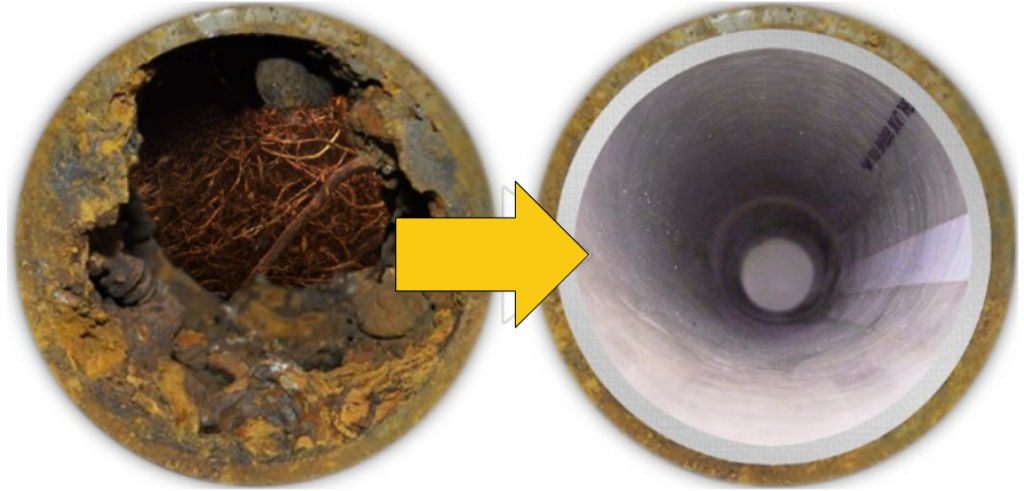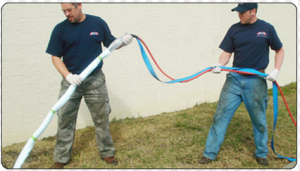Why Do Cast Iron Pipes Keep Backing Up?

Repeated Backups In Cast Iron Pipes Explained (With Suggested Repairs)
So, why do your cast iron pipes underground keep backing up and clogging?
Well, the answer is simple: cast iron pipes rust!
Water flows along the bottom of the pipe, and that’s where the corrosion occurs the fastest. So, the pipe at the bottom becomes thinner and thinner until a crack forms along the bottom. When the crack widens, the serrated edges of the pipe catch on debris. When that debris gets stuck there, it catches on more debris until eventually, the pipe clogs. Then you find out that the pipes have to be replaced.
The problem is that a plumber comes in with a video camera and tells you that you have to dig up all your floors, which means you have to replace your kitchen and bathroom cabinets, which means you have to remodel your kitchen and bathroom.
There are about 100 feet of cast iron pipe underneath a 2,000 square foot home, and that’ll take about six weeks to two months to excavate and replace all those pipes. They may have You have to resurface the floor. If you had matching tile or matching wood throughout the house, you have to redo all of that. And it’s a huge mess. The whole process involves excavating about 3 feet wide and 3 feet deep. All the sand gets piled up in your house next to the hole. So, you literally have to move out all the furniture into storage and go live somewhere else for two months. The average cost to replace a pipe bike that runs about $50,000 and you also have to get inspections done and permitting done.
The Solution - Trenchless Pipe Lining!
Our technology has been around since 1997. Most people don’t know about it, but it is called cured in place pipe lining or epoxy pipe lining. It simply installs inside the old pipe. It doesn’t matter if there are holes and cracks; it fills those in.
And it has a minimum engineered life of 50 years. Our warranty is 50 years to match the engineered life. When we’re done, we make a video recording of all the light pipes. We upload them online and send you one email with your 50-year transferable warranty, which means it can go to somebody else who buys the home in the future. You also receive the videos in that email, and you’ll receive a payment for the invoice. It takes about four days to do. That’s it.

What Are The Steps In Trenchless Pipe Lining?
Trenchless epoxy pipe lining is a process used to rehabilitate existing cast iron pipes without the need for traditional excavation methods. Here’s how it works:
Inspection: The first step in the process is to inspect the pipeline to determine the extent of the damage and identify any blockages or obstructions that may need to be cleared.
Cleaning: Next, the pipeline is thoroughly cleaned using high-pressure water jets or other specialized equipment to remove any debris or buildup.
Lining Preparation: After cleaning, the pipe is inspected again to ensure that it is clean and free of obstructions. Then, the epoxy resin liner is prepared according to the manufacturer’s instructions.
Lining Installation: The epoxy liner is inserted into the pipe and positioned using a specialized inversion system. The liner is then inflated and cured using hot water, steam, or UV light.
Inspection and Testing: Once the liner has cured, the pipe is inspected again to ensure that the liner is properly installed and that there are no leaks or other defects.
Restoration: The final step is to restore the pipeline to its original condition. This may include repairing any connections or fittings, as well as restoring any landscaping or pavement that was disturbed during the installation process.
Overall, trenchless epoxy pipe lining is a cost-effective and efficient way to rehabilitate pipelines without the need for excavation, making it an ideal solution for a wide range of applications.

How Much Does Epoxy Pipe Lining Cost?
So how much does it cost to reline pipes for a 2,000 square foot house instead of replacing the pipes?
It’s between $17,000 and $20,000. If you were to excavate the floors to physically replace the pipes it would take about two months and you would have to pay between $50,000 and $70,000.
It only takes 3 days to line the pipes, and we email you copies of the final videos of the re-lined pipes with your 50-year transferable warranty and your paid in full invoice. You get that all in one email. You can never lose any of that, and you can just forward that email to somebody who buys it properly in the future.
